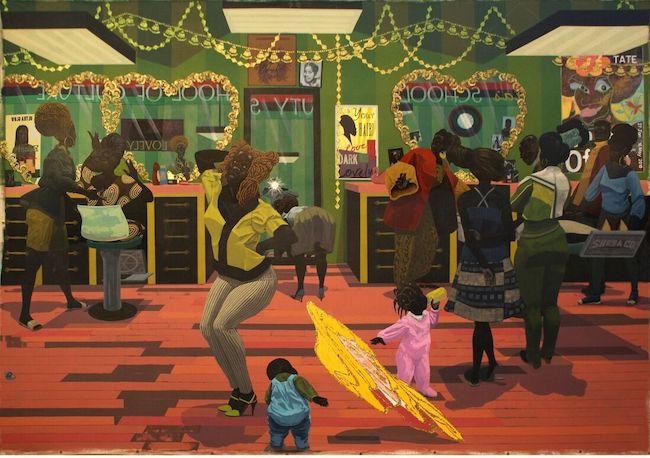Osservando il corso della storia dell’arte non si può fare a meno di compiere una profonda riflessione su quanto di fatto in tutto il passato riconosciuto e celebrato in Occidente siano stati inseriti pochi autori che mettessero al centro della loro ricerca pittorica le persone di colore, quelle che di fatto hanno da sempre costituito una considerevole presenza nelle realtà americane fino a costruirne la storia, seppur in modo più silenzioso. Il protagonista di oggi, artista celebrato in tutto il mondo per il suo approccio unico riguardo ai soggetti rappresentati, mette al centro della sua produzione proprio quella realtà afroamericana, l’osservazione della quotidianità dei sobborghi statunitensi che brulicano di vita e di abitudini diverse, certo, ma comunque sempre appartenenti a quella poliedrica e multiculturale struttura che costituisce il substrato americano.
Il mondo artistico di tutti i tempi ha sempre ruotato intorno ad autori, e soggetti, di pelle bianca nei periodi antecedenti al Novecento perché i committenti, e coloro che potevano permettersi l’acquisto di un’opera d’arte erano i sovrani, i nobili e la Chiesa, dunque personaggi con grandi capacità economiche che si aspettavano di trovare in un dipinto o in una scultura un’estensione di se stessi, con le stesse loro caratteristiche; con il colonialismo le persone di colore venivano prelevate dall’Africa per essere utilizzate come schiave nelle nuove terre e dunque non avrebbero mai potuto avere un ruolo da protagoniste nella società dell’epoca. Verso gli inizi del Novecento però cominciò a nascere un nuovo interesse verso tutto ciò che apparteneva alle culture indigene, inducendo molti maestri delle avanguardie a ispirarsi a quel mondo sconosciuto e tribale in cui tutto era diverso dal conosciuto, compreso il colore della pelle. Il Primitivismo, e in particolar modo le maschere africane, fu la base a cui attinse Pablo Picasso per creare la prima fase del suo Cubismo, quello che ebbe nelle Demoiselles d’Avignon la sua massima espressione, tanto quanto Amedeo Modigliani vi si ispirò per dare origine ai volti delle sue enigmatiche dame. Tuttavia queste influenze venivano tradotte sempre con tratti europei, bianchi, perché ancora non era stato compiuto quel percorso che avrebbe potuto condurre i collezionisti dell’epoca a scegliere di acquistare opere che raccontassero la vita di quegli indigeni. A rompere definitivamente questo schema fu Paul Gauguin che scegliendo di trasferirsi in Polinesia, lasciò al mondo meravigliosi racconti della semplicità e della spontaneità della vita dei nativi, modificando il gusto del pubblico che comincò ad apprezzare l’esotismo e il fascino di tutto ciò che era lontano dal proprio mondo. Dall’altra parte dell’Oceano, in America Latina, gli schiavi si erano affrancati e perfettamente integrati e stavano riscrivendo la storia di quei luoghi anche prendendo in mano l’arte, attraverso uno stile spontaneo che non richiedesse grande formazione accademica bensì soltanto il talento espressivo; parlo dello stile Naïf che ebbe nell’isola caraibica di Haiti ebbe una grande diffusione. A quel punto gli autori potevano raccontare la loro realtà, la quotidianità e i meravigliosi colori dell’isola, così come quelli della pelle della maggior parte dei suoi abitanti; massimi esponenti del Naïf haitiano furono Seymour Etienne Bottex, Jacques-Richard Chéry e qualche anno dopo Yvon Jean-Pierre; tuttavia lo stile sudamericano, sebbene molto celebrato in tutto il Sudamerica, non riscosse molto successo in Occidente, lasciando così gli artisti nati nel Nord a doversi aprire con fatica una strada più incisiva nel mondo dell’arte. Lo statunitense Kerry James Marshall raccoglie l’eredita di suoi grandi predecessori come Lois Malou Jones, Jacob Laurens e Faith Ringgold e sceglie di rendere omaggio alle persone di colore mettendole al centro della sua produzione artistica, per raccontarne tutti quei risvolti quotidiani, quelle piccole abitudini che hanno contribuito, seppur nella loro invisibilità, a costruire il tessuto sociale dell’America, a generare quelle tradizioni ormai comuni che sembravano essere state scritte solo dai bianchi.
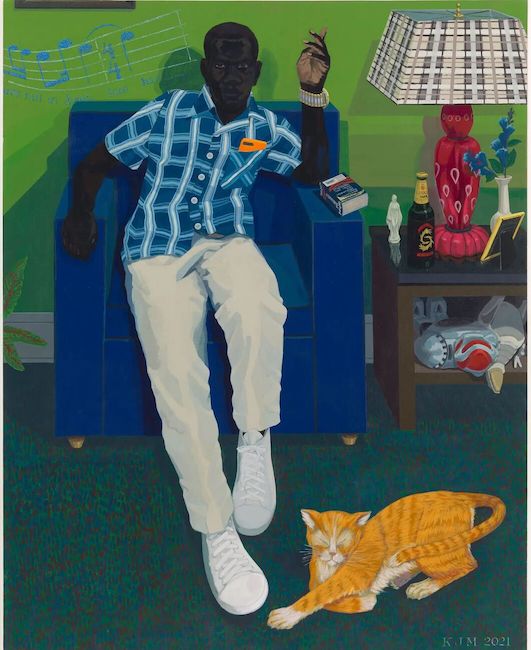
Il mondo raccontato da Marshall è variopinto, pittoresco, fuori dagli schemi di ciò che ci si aspetta di vedere perché a lui interessa raccontare il mondo della sua gente, rilassata, a volte pigra, altre dinamica nelle attività quotidiane, conservatrice di valori spesso incomprensibili alle persone di origine europea proprio perché provenienti da un altro continente dove tutta la scala di valori era diversa fin dalle origini; la sicurezza in se stessi che ostentano i suoi protagonisti nascononde di fatto la consapevolezza di non essere mai stati abbastanza rilevanti nel corso della storia moderna, sebbene ne abbiano fatto pienamente parte.
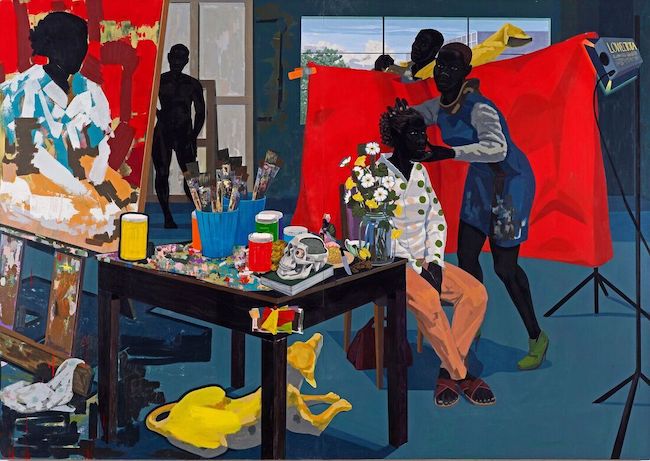
E così Kerry James Marshall decide di ribaltare completamente la prospettiva di osservazione, sceglie di raccontare solo ciò coloro i quali non sono mai stati raccontati, spia la quotidianità dei sobborghi e la immortala con l’immediatezza e la spontaneità di uno stile che da un lato assume i colori espressionisti, ma in realtà più vicini alle irreali tonalità Fauves, e dall’altro sceglie la rappresentazione semplificata del Naif dove però i personaggi non sono miniaturizzati perché farlo significherebbe ancora una volta ridimensionare l’importanza che invece hanno avuto nel processo di costruzione della società statunitense.
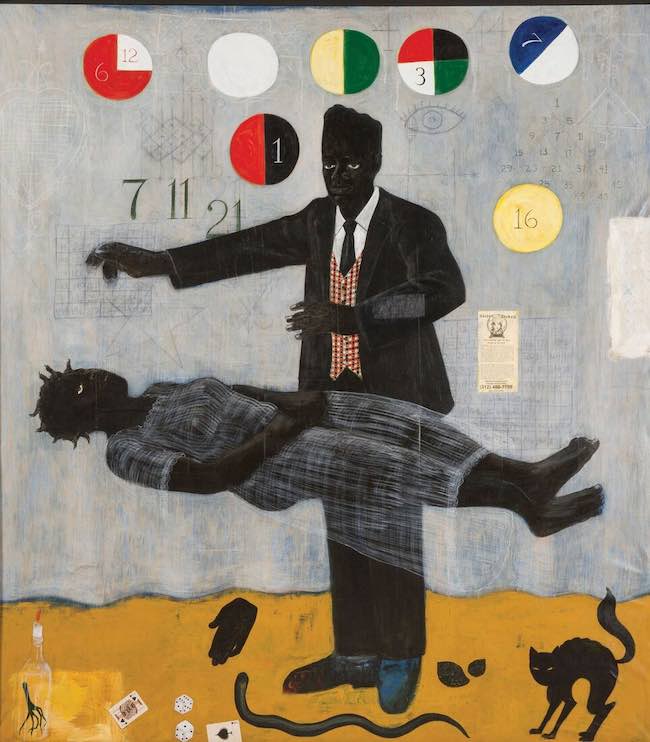
Lo sguardo di Marshall è autoironico, sia nella scelta di un colore della pelle decisamente innaturale, le persone di colore raramente hanno una tonalità vicina al nero, e sia nella definizione dei titoli che sembrano ironizzare sul modo in cui sono sempre stati descritti e guardati dalla maggioranza bianca, economicamente più abbiente e di conseguenza detentrice del potere.
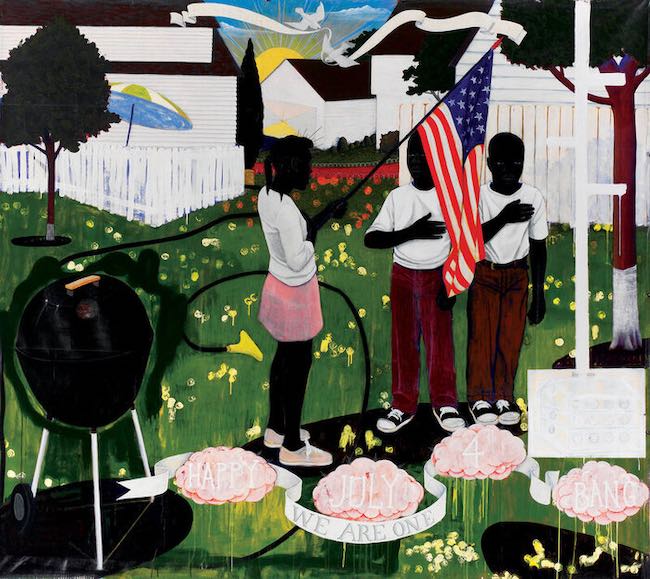
La tela Bang dark sembra essere la somma e il simbolo del pensiero filosofico di Kerry James Marshall perché i tre bambini, che evidentemente abitano nella periferia di una grande città, tengono in mano la bandiera a stelle e strisce nel giorno del Quattro Luglio, la stessa bandiera per cui i loro nonni e i loro genitori hanno dovuto lottare prima di potersi veder riconosciuto il diritto di poterla possedere sentiendosi americani; l’artista dunque prende un momento attuale lasciando che lo sguardo dell’osservatore sia conquistato dai colori e dall’immediatezza dell’immagine apparentemente ingenua e innocente, per poi condurlo verso l’approfondimento e la riflessione con le scritte sui cervelli sui quali si evidenzia quanto costò in termini di vite l’indipendenza dalla Gran Bretagna, sottolineando nel nastro che sembra unirli lo spirito di appartenenza a un solo grande popolo.
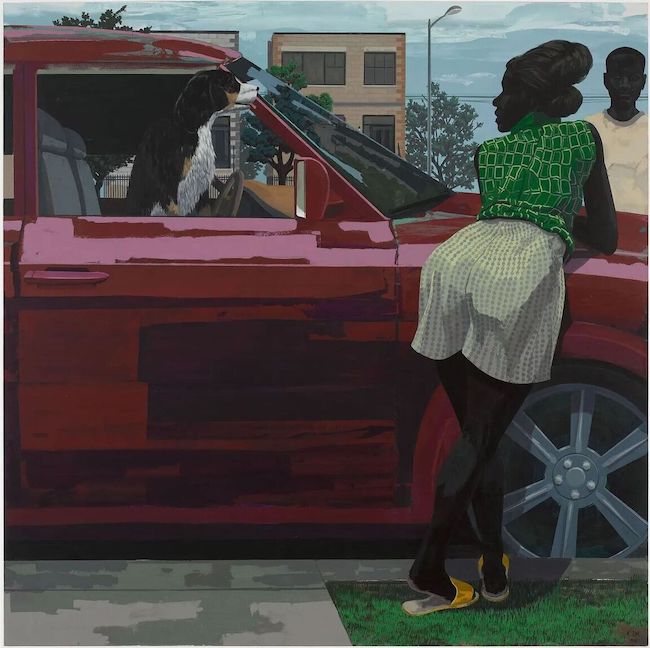
In Car girl 2 invece ciò che emerge è il ritmo lento, lontano dall’efficienza delle Downtown ma anche dallo stress che ne consegue, a cui la donna di spalle mostra con la sua posa, come se fosse in totale relax, parlando pigramente di ciò che la interessa, appoggiandosi sull’auto con sicurezza in se stessa, quasi si stesse pavoneggiando per attrarre le attenzioni dell’uomo di fronte a lei; la pacatezza che ne emerge mostra quanto l’autore della tela volesse semplicemente mettere in luce una quotidianità simile di fatto a quella degli scorci e dei ritratti dei maestri del passato, di cui erano protagoniste persone di pelle bianca, declinandola però secondo caratteristiche diverse che devono uscire alla luce e conquistare il loro posto nel mondo dell’arte mondiale.
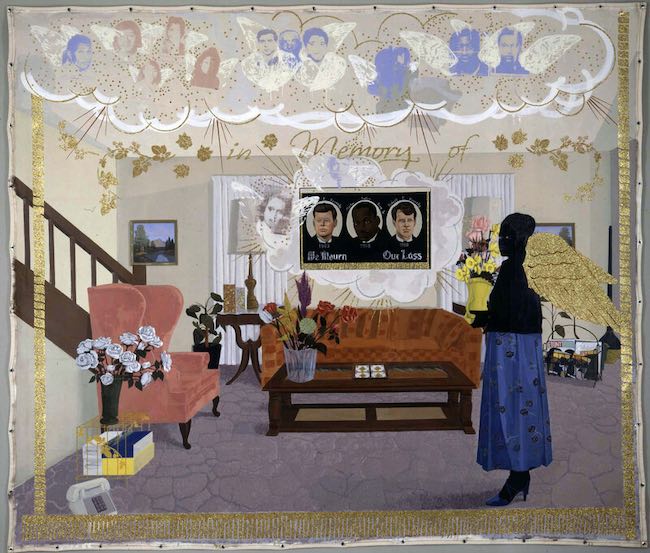
E ancora in Souvenir II Kerry James Marshall ritrae l’interno di un appartamento, avvicinandosi anche per la tecnica usata alle opere Pop di Richard Hamilton, in cui mette in luce i simboli degli afroamericani, quei personaggi che hanno combattuto e sono morti per difendere i diritti di una parte di popolazione troppo a lungo e ingiustamente sottomessa e considerata di serie B. Sullo sfondo di un soggiorno piuttosto lussuoso, appartenente probabilmente alla donna che è riuscita a uscire dall’anonimato e ad avere successo, le fotografie di Martin Luther King, John Fitzgerald Kennedy e suo fratello Robert, simboli di una lotta iniziata tanti anni fa e forse non ancora completamente finita; in primo piano, insieme agli oggetti e all’arredo che infonde alla tela un’atmosfera familiare, la protagonista con la pelle innaturalmente nera, è ritratta con ali dorate, citando vagamente la celeberrima opera di Caravaggio Riposo durante la fuga in Egitto. Kerry James Marshall diviene il mezzo attraverso il quale il suo popolo può riscattarsi dall’ombra nella quale è stato tenuto in passato, dalla mancanza di riferimenti aristici, se non in rari casi, che possano farlo sentire all’interno di un sistema che non lo esclude, inducendo così i giovani ad avvicinarsi a un nuovo tipo di arte che riesce a parlare o a raccontare un mondo a loro familiare, ritrovandosi.
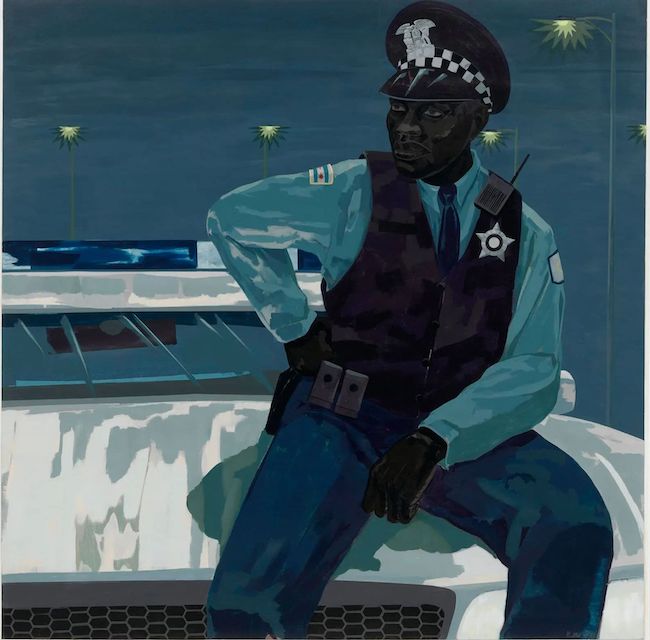
Kerry James Marshall è un artista riconosciuto a livello internazionale, ha al suo attivo mostre personali nei musei delle principali città del mondo e le sue opere fanno parte di numerose collezioni pubbliche tra cui l’Art Institute of Chicago, IL, il Birmingham Museum of Art, AL, il Los Angeles County Museum of Art, il Ludwig Museum, Colonia, il Metropolitan Museum of Art e il Museum of Modern Art di New York, il Museum of Contemporary Art, Chicago, la National Gallery of Art di Washington, il San Francisco Museum of Modern Art, la Tate Modern di Londra.
KERRY JAMES MARSHALL-CONTATTI
Email: info@jackshainman.com
Sito web: www.jackshainman.com/artists/kerry_james_marshall
Facebook: www.facebook.com/kerryjamesmarshall.gallery
Instagram: www.instagram.com/kerryjamesmarshall_
Kerry James Marshall’s Naif Expressionism, giving African Americans a prominent place in art
Observing the course of art history, one cannot help but make a profound reflection on how, in fact, in the whole of the past recognised and celebrated in the West, there have been few authors who put black people at the centre of their pictorial research, those who have in fact always constituted a considerable presence in American realities to the point of building its history, albeit in a more silent manner. Today’s protagonist, an artist celebrated throughout the world for his unique approach to the subjects he represents, places at the centre of his production precisely that Afro-American reality, the observation of the everyday life of the American suburbs that teem with life and habits that are different, certainly, but always belonging to that multifaceted and multicultural structure that constitutes the US sub-stratum.
The art world of all times has always revolved around authors, and subjects, of white skin in the periods before the 20th century because the patrons, and those who could afford the purchase of a work of art, were the sovereigns, the nobility and the Church, thus people with great economic capacity who expected to find in a painting or sculpture an extension of themselves, with the same characteristics; with colonialism, black people were taken from Africa to be used as slaves in the new lands and therefore could never play a leading role in the society of the time. Towards the beginning of the 20th century, however, began to emerge a new interest in everything that belonged to indigenous cultures, leading many avant-garde masters to be inspired by that unknown and tribal world in which everything was different from the known, including skin colour. Primitivism, and especially African masks, was the basis that Pablo Picasso drew on to create the first phase of his Cubism, the one that had its greatest expression in the Demoiselles d’Avignon, just as much as Amedeo Modigliani was inspired by it to create the faces of his enigmatic ladies. However, these influences were always translated with European, white features, because had not yet been taken the path that could have led the collectors of the time to choose to buy artworks that told the life of these natives. It was Paul Gauguin who definitively broke this pattern. By choosing to move to Polynesia, he left the world marvellous tales of the simplicity and spontaneity of the life of the natives, changing the taste of the public who began to appreciate the exoticism and charm of everything that was far from their own world. On the other side of the ocean, in Latin America, the slaves had freed themselves and perfectly integrated and were also rewriting the history of those places by taking art into their own hands, through a spontaneous style that did not require much academic training but only expressive talent; I am talking about the Naïf style that had a great diffusion in the Caribbean island of Haiti. The greatest exponents of Haitian naïf were Seymour Etienne Bottex, Jacques-Richard Chéry and, a few years later, Yvon Jean-Pierre; however, the South American style, although much celebrated throughout South America, did not meet with much success in the West, thus leaving artists born in the North to struggle to find their way in the art world. The American Kerry James Marshall picks up the legacy of his great predecessors such as Lois Malou Jones, Jacob Laurens and Faith Ringgold and chooses to pay homage to black people by putting them at the centre of his artistic production, to tell of all those everyday aspects, those little habits that have contributed, albeit in their invisibility, to building the social fabric of America, to generating those traditions that have become commonplace and that seemed to have been written only by whites.
The world Marshall narrates is colourful, picturesque, outside the box of what we expect to see, because he is interested in narrating the world of his people, relaxed, sometimes lazy, sometimes dynamic in their daily activities, preserving values that are often incomprehensible to people of European origin precisely because they come from another continent where the whole scale of values was different from the beginning; the self-confidence that his protagonists display conceals the awareness that they have never been relevant enough in the course of modern history, even though they have been fully part of it. And so Kerry James Marshall decides to completely overturn the perspective of observation, he chooses to tell only that which has never been told, he spies on the everyday life of the suburbs and immortalises it with the immediacy and spontaneity of a style that on the one hand takes on expressionist colours but actually closer to the unrealistic Fauves tones, and on the other hand chooses the simplified representation of the Naif where, however, the characters are not miniaturised because to do so would mean once again downplaying the importance they had in the process of building American society. Marshall ‘s look is self-deprecating, both in the choice of a decidedly unnatural skin colour – black people rarely have a shade close to very black – and in the definition of the titles, which seem to mock the way they have always been described and looked at by the white majority, who are economically more affluent and consequently hold the power.
The Band dark canvas seems to be the sum and symbol of Kerry James Marshall ‘s philosophical thinking because the three children, who evidently live on the outskirts of a big city, hold the stars and stripes flag on the Fourth of July, the same flag their grandparents and parents had to fight for before they could have the right to own it recognised as American; the artist therefore takes a current moment, allowing the observer’s gaze to be captivated by the colours and immediacy of the seemingly naive and innocent image, and then leads him towards deepening and reflection with the inscriptions on the brains on which he highlights how much independence from Great Britain cost in terms of lives, emphasising in the ribbon that seems to unite them the spirit of belonging to one great people. In Car Girl 2, on the other hand, what emerges is the slow pace, far from the efficiency of Downtown but also from the stress that comes with it, which the woman with her back turned shows with her pose, as if she were in total relaxation, lazily talking about what interests her, leaning on the car with self-confidence, almost as if she were strutting to attract the attentions of the man in front of her; the calmness that emerges shows how much the author of the canvas simply wanted to highlight an everyday life similar in fact to the views and portraits of the masters of the past, in which white-skinned people were the protagonists, but declining it according to different characteristics that must come to light and win their place in the world of art.
And again in Souvenir II Kerry James Marshall portrays the interior of a flat, also approaching the Pop works of Richard Hamilton in the technique used, in which he highlights the symbols of African-Americans, those people who have fought and died to defend the rights of a part of the population that has been too long and unjustly subjugated and considered second-class. Against the backdrop of a rather luxurious living room, probably belonging to the woman who managed to emerge from anonymity and succeed, the photographs of Martin Luther King, John Fitzgerald Kennedy and his brother Robert, symbols of a struggle that began so many years ago and is perhaps not yet completely over; in the foreground, together with the objects and furnishings that infuse the canvas with a familiar atmosphere, the protagonist with her unnaturally black skin is portrayed with golden wings, vaguely quoting Caravaggio ‘s famous work Rest on the Flight into Egypt.
Kerry James Marshall becomes the means through which his people can redeem themselves from the shadow in which they have been kept in the past, from the lack of aristic references, except in rare cases, that can make them feel part of a system that does not exclude them, thus inducing young people to approach a new type of art that manages to speak or narrate a world that is familiar to them, finding themselves. Kerry James Marshall is an internationally recognised artist, has solo exhibitions in museums in major cities around the world to his credit, and his works are part of numerous public collections including the Art Institute of Chicago, IL, the Birmingham Museum of Art, Alabama, the Los Angeles County Museum of Art, the Ludwig Museum, Cologne, the Metropolitan Museum of Art and the Museum of Modern Art, New York, the Museum of Contemporary Art, Chicago, the National Gallery of Art, Washington, DC, the San Francisco Museum of Modern Art, and the Tate Modern, London.


